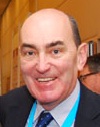In 2017 the Microwaves & RF Exhibition and Conference again shared the show floor with M to M and Objects Connectès (M2M and IoT to you and me) and Embedded Systems. All were housed under one roof, at Port de Versailles Expo, Paris on the 22nd and 23rd of March. The separate, yet linked trade shows each had their separate designated floor areas, identified by individual coloured carpet. Allocated light blue the Microwaves & RF exhibition featured around thirty booths.
The trade show has a French core and focus aimed specifically at the French speaking market – it is held in Paris after all! Alongside the exhibition there was a programme of conference sessions. My French translation permitting the forum included a session on 5G that covered backhaul networks at 94 GHz, trends for RAN and the challenges and opportunities at millimetre wave frequencies. A second session focused on amplifiers, including a presentation on silicon power amplifiers for 5G+ and IoT wireless communication applications.
On the show floor Computer Simulation Technology (CST) focused on the use and applications of CST STUDIO SUITE® 2017.The latest release of the EM and multiphysics simulation package introduces new features that extend the software’s range of applications. These features include both front-end and back-end improvements across the suite, with many focusing on tools for synthesizing and simulating components, as well as for managing and analyzing these components as systems.
Narda Safety Test Solutions highlighted the IDA 2 handheld portable interference and direction analyzer, which is a complete all-in-one measuring system that is tailored precisely to efficient source localization. It is a direction finder with the qualities of a receiver in a handheld format. The instrument now has I/Q analysis that allows users to reliably locate such signals. The instrument records the I/Q data in real time and saves up to 250,000 I/Q data pairs without compression, i.e. without loss of data. The company was also talking to visitors about the new SignalShark Real-Time Handheld signal analyzer for detection, analysis, classification and localization of RF signals between 9 kHz and 8 GHz.
National Instruments concentrated on two areas of activity. The first focused on the RF and microwave test sector with a demonstration of the capabilities of the NI PXI Vector Signal Transceiver. The second demonstrated the work of the NI Industrial IoT Lab that focuses on intelligent systems that connect operational technology, information technology and the companies working on these systems. A demonstration showed the role that the Compact Rio can play in such applications.
The focus for Noise XT was the SLC ultra low jitter 2 MHz to 7 GHz clock synthesizer. With -170 dBc/Hz phase noise floor at 10 MHz the SLC can challenge tomorrow’s requirements for high speed, high bandwidth Software Defined Radio application and low noise PLL and DDS synthesis. Its high power output can drive mixers’ LO inputs or high-speed digital clocks. Its very low jitter profile offers accurate ADC and DAC testing and it also offers a high SNR of up to 135 dB.
Rohde & Schwarz showcased the new R&S RTB2000 series of low cost, entry-level oscilloscopes that offers touchscreen operation as well as a 10-bit vertical resolution that is designed for education, R&D and manufacturing applications. The series comes in two and four channel models and offers bandwidths of 70 MHz, 100 MHz, 200 MHz and 300 MHz. The instrument offers the ‘Power of Ten’ by providing a 10-bit Analogue to Digital Converter (ADC), 10 Msample memory and 10.1" capacitive touchscreen.

